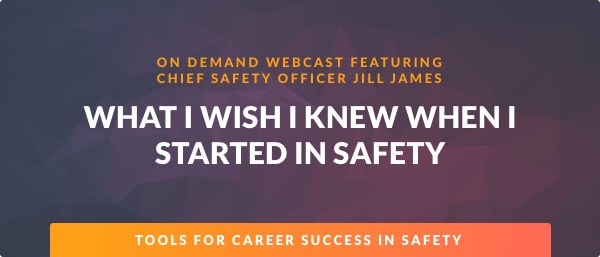Safety Blog Series: Part 2 | You’ve Got the Job. Now What?

Welcome back! So what’s next now that you have this safety position?
In Part I we talked about the power of a checklist; something you can rely on to stay the course, help you focus, and ensure a strong foundation. I offered a few name options for your checklist including, Basic Safety Compliance or Safety Basics or Safety 101.
I said there were 5-items on your checklist in Part I and we covered the first one: Determine which OSHA and safety laws apply to your company.
Let’s move on to the second item.
Checklist Item #2
Written Programs, Assessments, Certifications and Procedures
Yuck. Unless you love reading regulations, interviewing departments on tasks they perform, dissecting what you’ve read and heard, leaving out no details, and then writing it all down in a manner people can follow and aligns with a specific law, this checklist item is akin to untying 1000 knots from the shoe laces of 50 preschoolers who asked you to help them tie their shoes.
Sorry, but it’s true.
Let’s untie a couple of those knots and see if I can make it easier.
Knot 1: Ever read an OSHA law? No?
That’s sounds like another blog post. Actually, it was an entire course when I was in Graduate School to become a safety nerd, excuse me, I mean Safety Professional.
Serious; an entire course dedicated to reading OSHA laws.
Someone remind me to write that blog post, okay?
Here’s your quick lesson . . .
Let’s say you’ve discovered (from blog #1 of this series) your industry needs to comply with Part 29 CFR 1910 for General Industry set of laws. There are 26 Subparts (A-Z) within 1910.
Gulp.
Here is an example of how those Subparts are broken down (mini knots within a big knot)
1910 Subpart I is titled, Personal Protective Equipment
There are 7-Sections of Subpart I and they have a fancy numbering/naming system:
- 1910.132 General Requirements
- 1910.133 Eye & Face Protection
- 1910.134 Respiratory Protection
- 1910.135 Head Protection
- 1910.136 Foot Protection
- 1910.137 Electrical Protective Devices
- 1910.138 Hand Protection
And, each of those Sections has Subsections, paragraphs and some have appendices.
Dizzy yet? Stick with me please!
Buried within the subsections are where you will read whether or not there are requirements for a Written Program, a Written Assessment, Written Certification or a Written Procedure.
Understand now why I said, Yuck?
Knot 2: Knowing the difference between a, Program, Assessment, Certification and Procedure
We’re digging deeper now, finding out what you actually have to put in writing. Let’s stay with our Personal Protective Equipment law dissection for this knot, okay?
Written Assessment Example: 1910.132 General Requirements has a subsection (d)(1)(i)-(iii) & (d)(2)
Here is what that subsection says verbatim:
The employer shall assess the workplace to determine if hazards are present, or are likely to be present, which necessitate the use of personal protective equipment (PPE). If such hazards are present, or likely to be present, the employer shall:
- Select, and have each affected employee use, the types of PPE that will protect the affected employee from the hazards identified in the hazard assessment;
- Communicate selection decisions to each affected employee; and,
- Select PPE that properly fits each affected employee. Note: Non-mandatory Appendix B contains an example of procedures that would comply with the requirement for a hazard assessment.
- The employer shall verify that the required workplace hazard assessment has been performed through a written certification that identifies the workplace evaluated; the person certifying that the evaluation has been performed; the date(s) of the hazard assessment; and, which identifies the document as a certification of hazard assessment.
You really only needed that last bullet point, but the stuff above it gives you context.
Are you wondering what that last bullet point even means?
Let’s see if I can put that in plain language . . .
You look around at the tasks/jobs people do. You decide if any of those jobs need PPE. If you aren’t sure, you ask for help. You decide which PPE is the right choice for the task/job. For example, picking the correct filter on a respirator for the hazard or picking the correct glove material for the chemical being handled. Then, you write yourself a note, detailing why some tasks/jobs need people wearing the PEE and why you picked the kind of PPE you did.
The process of figuring out who needs PPE and what kind is the assessment. Putting it in writing is the certification. Your employees do not need to have this handed out to them unless for some reason they asked for it. This is your certification to file and whip-out in the event of an audit and to use as your own reference tool.
Do you need a special degree yourself to do this? Nope.
What if you really don’t know about the jobs/tasks or hazards people are exposed to and you need help? It’s okay, I’d need help too. Here are two resources:
- Your Workers Compensation or Property/Liability/Casualty Insurer. They employ safety people who can help you or do it for you. Ask them. That’s why you pay premiums & fees.
- A PPE supplier who employs safety and/or Industrial Hygienists. 3M is great at this.
Knot 3: Knowing the difference between a, Program, Assessment, Certification and Procedure
Dissection continuing of the Personal Protective Equipment law, let’s go to 1910.134 Respiratory Protection-Subsection (c)(1)-(c)(2) This section is huge-here is a piece of it . . . .
In any workplace where respirators are necessary to protect the health of the employee or whenever respirators are required by the employer, the employer shall establish and implement a written respiratory protection program with worksite-specific procedures. The program shall be updated as necessary to reflect those changes in workplace conditions that affect respirator use. The employer shall include in the program the following provisions of this section, as applicable:
- Procedures for selecting respirators for use in the workplace;
- Medical evaluations of employees required to use respirators;
- Fit testing procedures for tight-fitting respirators;
- Procedures for proper use of respirators in routine and reasonably foreseeable emergency situations;
- Procedures and schedules for cleaning, disinfecting, storing, inspecting, repairing, discarding, and otherwise maintaining respirators;
So, this law outlines a requirement to have a written program and details-out what it has to cover, including specific procedures.
Are you wondering, do I really have to write all that? The answer is yes.
If you have employees who are exposed to workplace hazards and those hazards are linked to a law such as PPE or Lock-out Tag-out or Emergency Action Planning and the those laws require a written program, assessment, certification or procedure, then you must have one.
What if there isn’t a law, but your industry or company has a best practice around safety stuff not covered by a law? Then, you treat it as if there were a law and build written documents around it.
Now that there is a knot in your stomach, let’s see if I can untie it for you.
Do you have to write all this stuff from scratch yourself?
No.
Here is the great part about a career in safety...we all get how hard this can be and are willing to share!
Truly. There isn’t anything proprietary about safety programs, assessments, etc.
I’ll start the sharing.
Here is a link to a written safety program template. It’s a template and you can customize it for your company. More written safety program templates.
It’s a general safety program. It’s what Federal OSHA would like everyone to have, but they haven’t been able to pass a law requiring one. Many states have one however, and you might be in a state requiring one.
A general safety program addresses how your company handles workplace safety. It sets the stage for all other safety pieces.
Take a read through it, you’ll get it. Pretend you just got hired and you are given this document; it clearly explains how safety works, what you can expect, what’s expected of you and for which subjects training will be provided.
Who is next? Who has a great written program, assessment, certification or procedure you would like to share? Contact us! We could turn it into a template, share it with others and provide you the thanks!
Stay tuned for Part III of this series where we will figure out which safety subjects you need to be providing training.

This is part 2 in a three-part series, to read the other two posts, visit:
- Safety Blog Series: Part 1 | You’ve Got the Job. Now What?
- Safety Blog Series: Part 3 | You’ve Got the Job. Now What?



